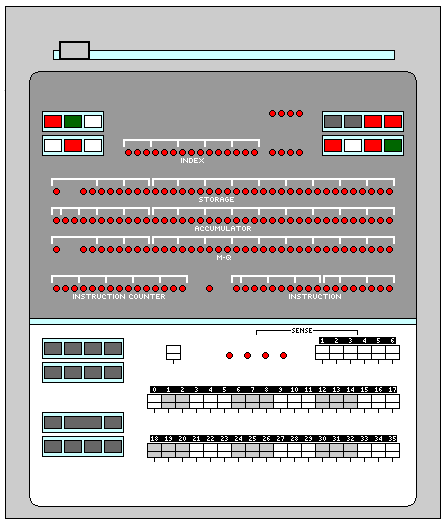
Old-style computers, made from vacuum tubes, discrete transistors, or small-scale integrated circuits, allowed direct access to their internal signals.
An early computer, like the vacuum-tube based IBM 704, had a simple front panel, with rows of lights corresponding to the registers encountered by the programmer, a set of switches on which to enter a value, and a few buttons to perform simple functions.

This style of front panel resembles that of many minicomputers, such as the Digital Equipment Corporation PDP-8, one model of which, the PDP 8/I, is illustrated here:
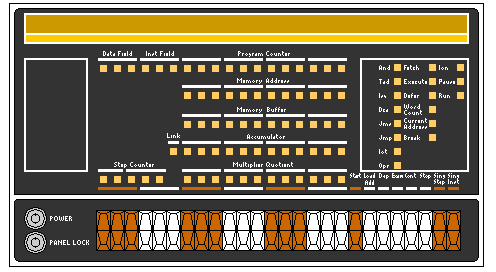
or the Hewlett-Packard 2115A, as illustrated below:
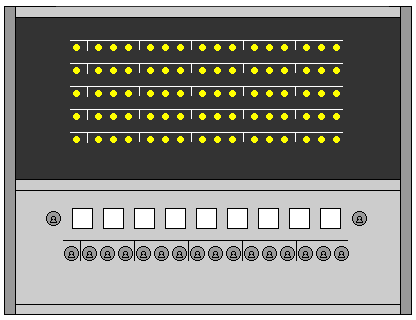
or the DDP-119, or the GE-235, or the DC 6024, or many others.
In fact, these computers resembled the IBM 704, and its descendants (the IBM 709, 7090, 7094, 7094 II, 7040, and 7044) in other important ways as well; one of the most noticeable is that every assembly-language mnemonic for many minicomputers was exactly three letters long.
The 36-bit PDP-6 (and its successors, the PDP-10 and the DECSYSTEM-20) even used a floating-point format identical to that of the 704 for positive numbers. For negative numbers, the format was modified so that integer comparisons would be applicable to floating-point numbers; the SDS Sigma computers made exactly the same type of modification to the floating-point format of the System/360!
The first PDP-10, with the KA-10 central processor, also had a conventional front panel, and it used the same type of rocker switches as used on the PDP-8/I (and the PDP-12 and the PDP-15), and, as this is also a machine very fondly remembered, its front panel is pictured below:
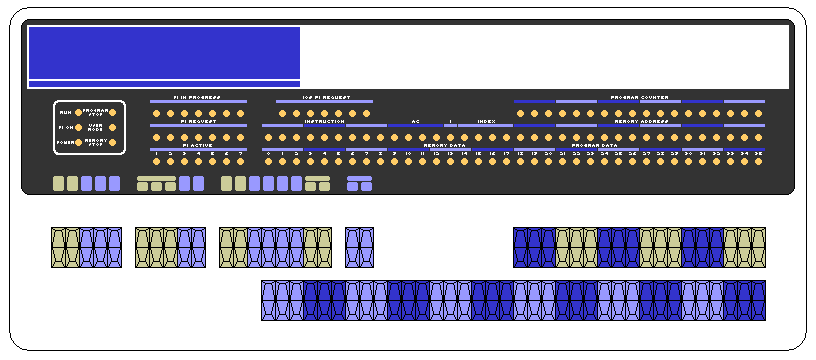
Note that the panel has been flattened for purposes of this illustration; the part of the panel with the lights was in fact tilted slightly back from the vertical, while the part with the switches was tilted slightly down from the horizontal.
Like the original PDP-8, the KA-10 version of the PDP-10 was actually built from discrete transistors instead of integrated circuits. As with the PDP-9, at the time these computers were designed, in 1966, integrated circuits were not yet seen as offering cost and speed advantages, but the switch to monolithic integrated circuits would be made shortly thereafter.
As the PDP-10 had 16 general registers, while the program counter was still displayed on the front panel in addition to the contents of the address and data buses, there was no single accumulator to display. More abbreviated front panels of this type, often even without the program counter, were also found on the PDP-11, with eight registers, and, out of necessity, since the chips did not bring out signals with the contents of their internal registers, on those microcomputers that had front panels, such as the MITS Altair, the IMSAI 8080, or the Texas Instruments 990/4, for example. Of course, for a computer to have seven index registers was not an insuperable barrier to displaying them all on the front panel, as that of the IBM 7094 proved; starting from the front panel of the IBM 7090, which displayed its three index registers, a subsidiary panel was placed atop the unit to display the additional four registers added for that machine.
The first PDP-11 had a front panel resembling that of the PDP-8/e, but later versions of this popular computer had unique front panels which were quite stylish in appearance. For a time, it seemed as if the Digital Equipment Corporation, with its PDP-11 line of computers, and Data General, with first the Nova 3 and then its Eclipse computers, were competing against each other to see who could make the computer with the most stylish front panel.
Photographs of the computers the front panels of which are shown here by means of diagrams are, of course, available elsewhere on the web, and those who view these pages are certainly encouraged to look for these as well. This is particularly true in the case of front panels such as those of the PDP-11 and the Nova 3 and the Eclipse. I had originally felt that it would not be possible to attempt the front panel of the PDP-11/45 and similar models as a diagram, but I have now become bolder in this regard.
Not that it is wrong to make a computer look modern and futuristic. In connection with this, it may be noted that the Honeywell 316 computer was offered in an alternate configuration, where, instead of being rack mountable, it was in a freestanding enclosure with a sloped front. In this form, it was offered to (relatively wealthy) consumers in the Neiman-Marcus catalog. As it happens, the PDP-8/I computer, with its front panel pictured here as it is in the conventional configuration, also had such an alternate configuration, although without the gentle curves of its competitor.
Before the IBM 704, a commercial core-memory computer, was produced, IBM had manufactured the AN/FSQ-7 computer for the SAGE air-defense system. This computer had a great many lights and switches; most of those did not correspond to anything seen by the programmer, but served purposes related to maintenance instead.
While the 704 didn't continue that trend, it was picked up again in many later IBM mainframe products.
The IBM 7030, or STRETCH, was a computer built from discrete transistors that had a maintenance panel with quite an assortment of lights:
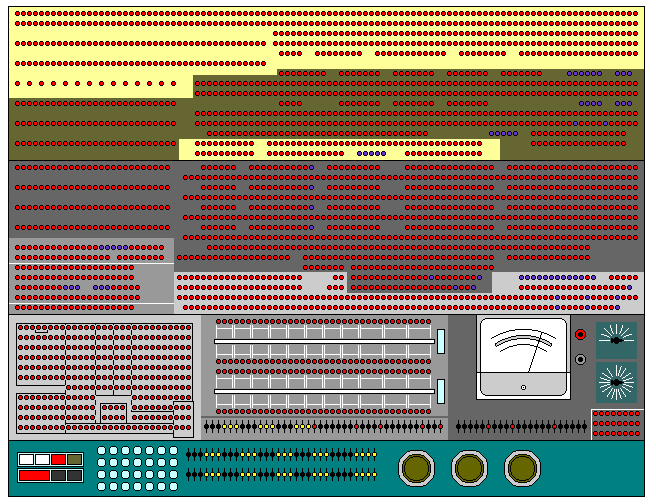
and the front panels of some of the high-end models in the System/360 line were also impressive, such as the IBM System/360 Model 75, the hardwired (instead of microprogrammed) member of IBM's initial lineup:
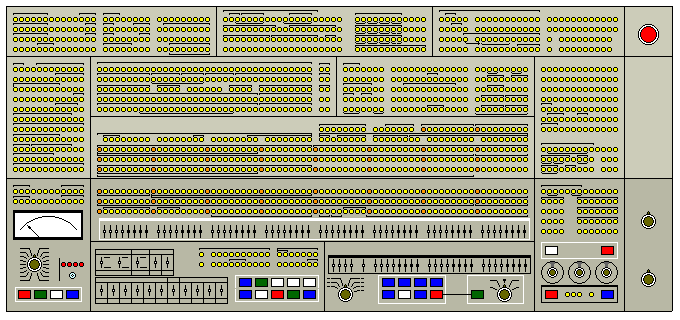
and the IBM System/360 Model 195, which had pipelining, cache, and a floating-point multiply unit that operated on multiple bits at once for speed, all just about like a Pentium, (but the Pentium used SRT division, not Goldschmidt division) had the following front-panel:

Almost the same front panel appeared on the System/360 Model 91, which had a pipeline but no cache, and the System/360 Model 95, which used thin-film memory.
Actually, although the original Pentium was pipelined, it was still in-order. The Pentium II, or the Pentium Pro, would be a closer comparison to the IBM System/360 Model 195, because both those two Intel processors, and the IBM mainframes related to the Model 91, had an in-order integer unit, but an out-of-order floating-point unit, so, although the Pentium Pro and Pentium II had a much faster clock frequency, that of the Model 195 being close to 16 MHz, they were fundamentally similar in a microarchitectural sense.
These panels have also been flattened as drawn here, although the alteration is more modest than that in the illustration of the KA-10 PDP-10 front panel.
On the next page, to prevent this page from being too slow to download, is an image of the ultimate front panel.